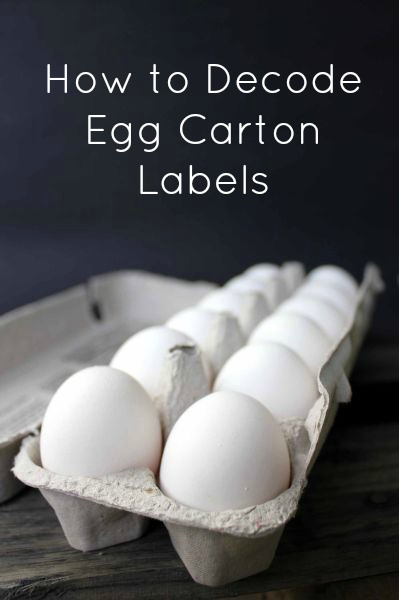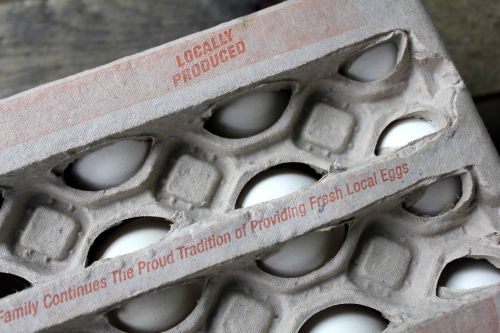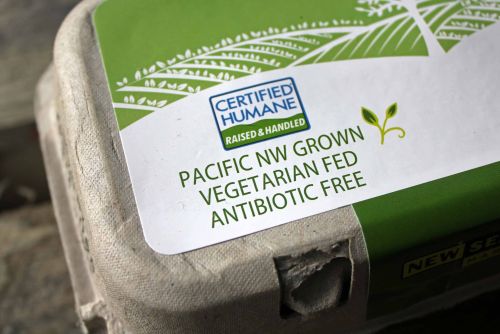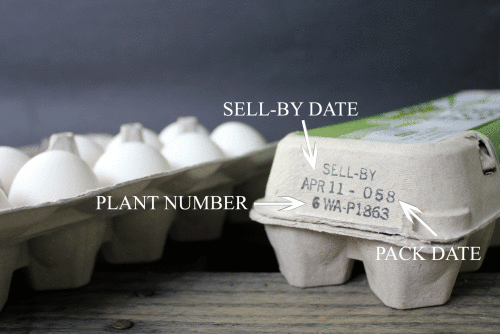Understanding Egg Carton Labels
Spring is here, so let’s talk eggs! I love eggs, but they are probably the one item on my grocery list that give me the most trouble. Anyone else feel this way?
For example, a dozen eggs may go on sale for 99¢. Great price! But I hate the thought of sick hens in cramped cages. I put them back on the shelf. Do I pay three times as much for the cage-free option? Or even more for the humanely raised eggs? What’s better: local eggs labeled as natural or eggs trucked in from Ohio labeled as organic? Omega-3? Vegetarian feed?
Ack! I barely resist the urge to crumple into a heap in front of the dairy case.
Something’s gotta give. Especially considering my family eats a respectable amount of eggs. I usually buy 2-3 dozen at a time, which lasts us 1-2 weeks.
When we run out of eggs, my husband hops on his bike and pedals one mile down the road to a neighbor with a flock of happy hens in the backyard and a sign advertising “Fresh Eggs” in the front. He comes home with a carton of eggs swinging from a bag on his handlebars. The eggs are beautiful, large and speckled with bright yellow yolks, but they cost almost twice as much as the grocery store and aren’t always available. Eggs are tricky like that.
So we bounce between the grocery store and the local coop, dreaming of the day when we will have some chickens of our very own. Until then, I am stuck decoding egg cartons.
Common Egg Carton Labels:
Cage-free: Just as the name implies, these hens are uncaged. Most are housed in large indoor barns and do not necessarily have access to the outdoors. Because of the large populations, these hens may also be given antibiotics to prevent infections and diseases from spreading, but they do have some space to walk and stretch. Beak cutting (to prevent hens from pecking each other) and starvation practices are allowed with this group; there is no third-party auditing.
Free-range/free-roaming: These egg-layers are also uncaged and generally get to hang out outside a bit more, although this is not guaranteed. Even though you’ll pay more for these eggs, the USDA has not imposed any set care standards. Feed is not regulated and beak cutting and forced molting are still allowed.
Certified organic: To be in this category, hens are required to be uncaged and have outside access. Their feed must be organic and all-vegetarian with no antibiotics, drugs, pesticides, or animal byproducts. Their living conditions are usually not as tight. This category is checked and certified by a third party, where the first two are not.
:: Certified Humane: These hens are uncaged inside large barns or warehouses. They are not required to have outdoor access, but they must be able to engage in natural behaviors like nesting, perching, and dust bathing. There are requirements for population density and the number of perches and nesting boxes. Forced molting through starvation is prohibited, but beak cutting is allowed.
Vegetarian-fed: As the name suggests, feed given these hens does not contain animal byproducts.
Natural: This pretty much just means no regulations.
Omega-3 enriched: Hens in this group are fed a diet rich in omega-3 fatty acids, usually by adding flax seed to the feed. The eggs typically have double the amount of omega-3’s as regular eggs, but at about twice the price.
Important Egg Carton Numbers:
Plant Number: This information is helpful in case of recall or other issues with your eggs.
Pack Date: This is the date the eggs were washed, weighed, and placed in the cartons. The 3-digit code (Julian date) corresponds to a day of the year (001 = January 1 through 365 = December 31)
Sell-By Date: In all USDA-inspected plants, the sell-by date may not exceed 30 days beyond the pack date. Assuming it has been refrigerated from the time of packing, eggs should be good for at least 2-3 weeks beyond their sell-by date.
Information Sources:
- The Humane Society of the United States: Egg Carton Labels
- The Oregonian, FOODDAY, Sorting Out the Language on the Egg Carton
- What’s Cooking America: How Fresh Are Your Eggs?
This post may contain affiliate links. See the disclosure policy for more information.




So glad I don’t have to buy eggs, I would go crazy thru all the terms. Love my backyard flock! We have great pets, kids enjoy 4H activities, learning, and prizes for their birds and knowledge.
My chickens are fed non-gmo and non-medicated food. They are free ranged but protected from preditors.
As for hard boiled eggs… Steam them! 20 minutes. Easiest eggs to peel ever, shell almost falls off.
Yes I have just been buying conventional eggs because I have changed our diet in many ways- the costs are enormous. I feel like I can’t do organic, then what’s the point. Even people that raise them at home likely still feed them GMO feed (likely GMO corn). They are more humane, but you are what you eat.
The egg carton in the picture has a pack date of 58 = Feb 27. April 11, the sell by date would be Julian 101. So these eggs will be on the shelf for 43 days, which is more than the 30 days this post says USDA inspected eggs should be on the shelf.
Huh. Nice catch! I hadn’t noticed that.
On the USDA site, it also says: “Another type of code dating used indicates the recommended maximum length of time that the consumer can expect eggs to maintain their quality when stored under ideal conditions. Terminology such as “Use by”, “Use before”, “Best before” indicates a period that the eggs should be consumed before overall quality diminishes. Code dating using these terms may not exceed 45 days including the day the eggs were packed into the carton.”
This carton is clearly labeled “sell by” though… I’m going to check these cartons the next time I’m at this store. If the dates are still longer than 30 days, I’ll try to track down an answer for you!
This still doesn’t tell me when the eggs were laid. I suppose in most cases, eggs at these places are washed and weighed within 24 hours of laying. I wish the cartons would say, “Laid on YYMMDD”. Fortunately, I don’t have to buy store eggs. I’ve got a great flock of hens and roosters and can have eggs that have just been laid. I also sell about 14 dozen eggs a week, and I mark each egg with the date it was laid so that my customers know exactly how fresh their eggs are. If I know the hen who laid the egg, her name goes on the egg too.
This is how I boil chicken eggs. Place cold eggs in a pot and fill with cool water; about an inch above the eggs. Turn the burner on high. When the water comes to a boil, remove the pot from heat; do not lift the lid. Set the timer for 17 minutes. When the time is up, carefully pour out hot water and fill with cold ice water. Let the eggs cool 5 minutes and replace the water again with ice cold water for 5 more minutes. We have 5 children and this method works for their little fingers to easily peel eggs. Hope it works for you too.
Awesome post Emily! What you said at the beginning is exactly how I feel…can’t stand the thought of chickens in cramped cages. But I wondered if cage free really meant cage free. Thank you!
Thanks for this post and for all the comments. It was very informative and appreciated! 🙂
but fay,you should know that chicken feed with antibiotics is readily available at the local feed store…so, if you want to be sure you are going to have to buy organic or raise your own.
Just a thought about antibiotics. I too, have back yard hens and we have done quite nicely with beautiful eggs for a few years now. Which I will say is very much worth the work 🙂 This winter, however, my hens got sick, 2 died and I ended up having to give the rest antibiotics. I learned that for MOST antibiotics given to chickens, there is a withdrawal period during which it is not recommended to eat the eggs after giving antibiotics. We had to put eggs down the disposal for 2 weeks. Not a huge fan of using antibiotics but it was worth it to not loose all my hens. Companies are required to adhere to these standards (unless of course they didn’t get caught!). In general sick hens don’t lay well and in commercial farms they are culled if they can’t be cured.
Emmer, the feed store feed contains “medication” to stop the reproduction of a parasite called coccidosis, something that does not usually affect humans but is very deadly to growing birds. This medicine is something called Amprolium and it is a derivative of thiamine (vit b1). It is absorbed into the bug’s reproductive system so it cannot reproduce, causing the bug to die out, thus curing the birds. Look it up if you are curious. Although this is a “medicine” it is not an antibiotic.
Usually most birds are immune to this parasite by about 20 weeks old (about the time they start laying) and they do not need to be medicated for this any more.
I always laugh when I see the “vegetarian fed” on the carton. I had hoped that referred to the feed they were given and not what they could actually eat since chickens aren’t naturally vegetarians. We raised chickens when I was growing up and chickens love going after all the bugs in the back yard or garden area. You can definitely see the difference between store eggs and eggs from chickens raised at home.
Tip to find out if an egg is still good after the “best buy” date.
Put it in a glass of cold water. If it sinks … it’s good to eat.
If it floats, toss it!!
I found this tip years ago & have been doing this since then & it really works!
Wow..that’s alot of eggs to go through in such a short period of time.
We go through a minimum of 2 dozen every 1-2 weeks and we are a family of four. Eggs are such an inexpensive protein!
Great post Emily! The labels are so darn confusing, it’s no wonder people have no idea what to buy. We are lucky and get ours from a friend with chickens for $2/dozen, but when those aren’t available, we buy the organic eggs from Costco at $3.50/dozen. Even though it is more expensive than buying the regular eggs at the store, it’s not as huge of a budget buster as going to all grass-fed beef, so this is where we’ve started.
I just walk out to the backyard coop and pluck an egg or two directly from the nest. I know exactly which hen laid which egg. Not only do they provide me with fresh eggs, they till the garden, eat creepy crawly critters, eat lots of my veggie scraps, and help fertilize the yard and garden. Selling the extra eggs also helps towards their feed costs. Besides, they are just fun to watch and listen to as they contendedly cluck, commenting on what they are finding, or asking for more goodies from me.
Thank you!
We also go through 1-2 cartons a week.
I was wondering about the omega 3 eggs and how that all worked.
Thanks for the help
Are you implying that “regular” and “natural” eggs are not antibiotic free?
No, just that they are loosely regulated. According to the Incredible Egg site, “Antibiotics are not used on a continuous basis in the egg industry. If hens become ill and antibiotics are needed, they’re used on a therapeutic level under the supervision of a veterinarian. If hens are given an antibiotic at this level, their egg production is likely severely depressed. Any eggs produced would be diverted from human consumption according to FDA regulations.”
thank you.
I agree, I love knowing exactly where my free-range, scrap eating, rich buttery eggs come from. My girls are their roaming area is bigger than some peoples backyards. I think we all need to be a bit closer to our food sources.
Thanks for this post. Very informative.
I’m very glad we have our own chickens so I don’t have to figure this all out!!! I know exactly where my eggs come from … sometimes even which chicken 🙂
funny, me too. Last time I took eggs to my brother, he laughed because I knew which eggs came from which hen
I went to see a psychiatrist because my brother thinks he’s a chicken. “Bring him in,” he said, “I can help him.”
“On second thought,” I said, “I better not. We need the eggs.”
HA! Thanks for posting! My family and I have decided to go organic for most of our meat and dairy purchases (costco steaks and tillamook cheese are fine.) just recently after testing out a few meals with the changes my girls asked for seconds because the food was so good! Just yesterday I felt pretty stupid reading all of the different egg cartons at whole foods! LOL!!!
Unfortunately this is the email I got back from Tillamook:
Thanks for your email. Our farmers know that happy, healthy cows make the best quality milk and part of this is a healthy diet. The farmer-owners and all the dairymen who supply milk for Tillamook dairy products use a variety of forages and grains for feed. While the mixture varies dairy to dairy, it’s likely to include a mix of grass, alfalfa, some corn silage, and grains such as barley or soy. All of this is balanced by a nutritionist who also adds a vitamin/mineral supplement to ensure the healthiest cows possible, and thus the highest quality milk. The feed used by our farmers and suppliers is both home grown on our farmer’s fields and purchased. With the prevalence of GMO feed, it’s difficult to avoid; 95% of all soybean and 80% of all corn production in the U.S. is of the GMO variety making non-GMO feed hard to obtain and limited to the organic marketplace.
I hope this information is helpful.
Thanks,
Candace Butler
Consumer Loyalty Specialist
PO Box 230667 • Tigard, Oregon 97281
phone: 503-619-4231 facsimile: 503.639.7037